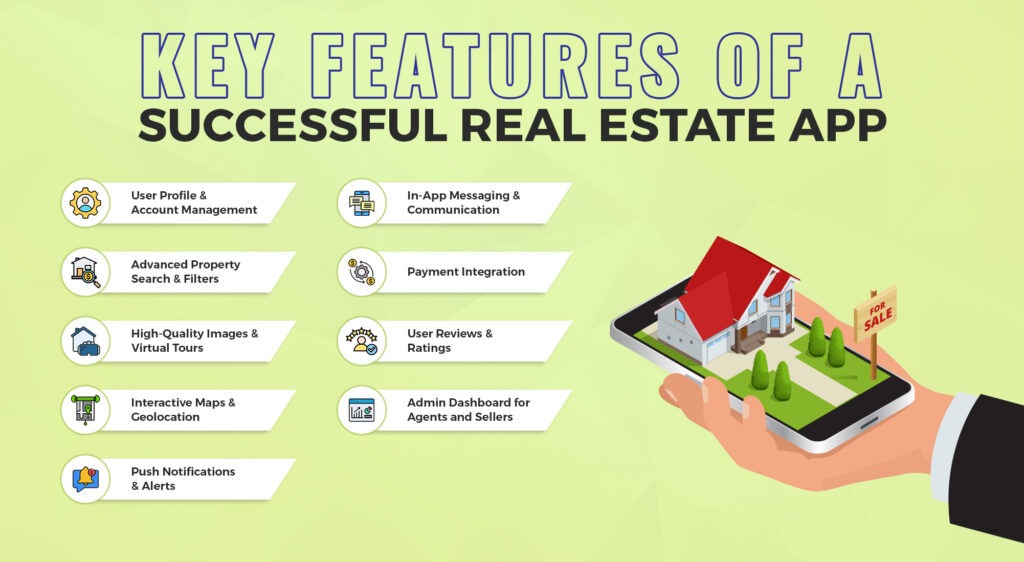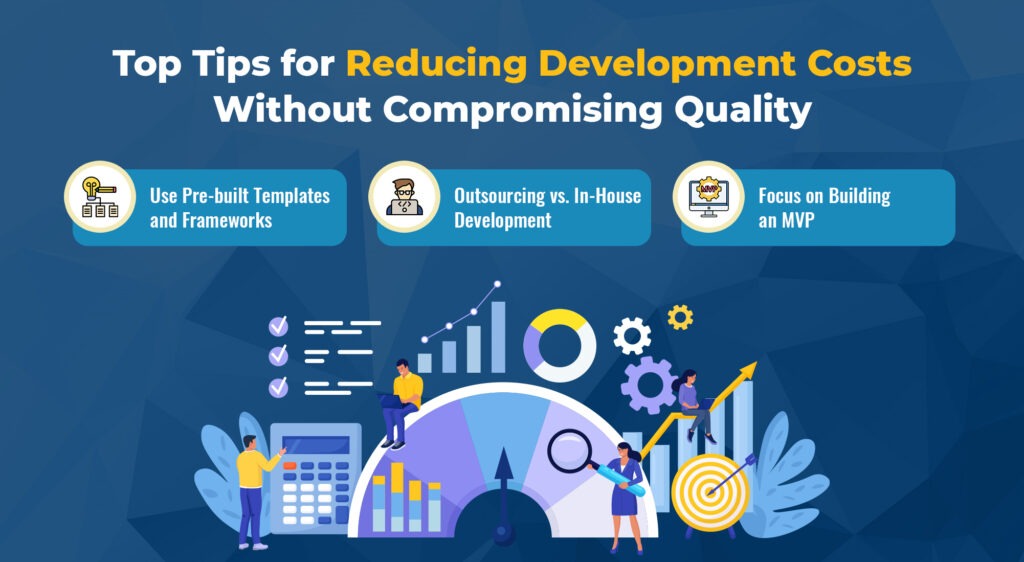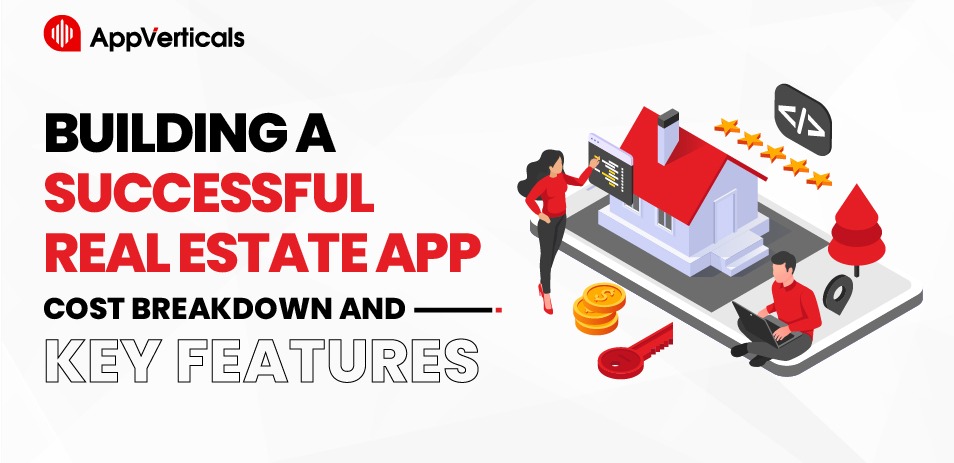Real estate apps have made the process faster and easier than ever before! The global real estate technology industry is expected to become a $14 billion industry by 2026. Imagine having instant access to property listings, virtual tours, and cool interactive maps – all on your phone!
Building a real estate app that people love is important. It needs to be easy to use and look good. You also need to know how much it will cost to make, cost to hire the best app development company, and more.
This blog will tell you everything you need to know about creating a real estate app like Zillow, including what features it should have and how to save money.
Let’s discuss it in detail!
Key Features of a Successful Real Estate App
A real estate app needs to look good and be easy to use. It also needs to have important features that help people find and buy homes. Here’s a breakdown of the most essential features, each playing a crucial role in making an app useful, efficient, and competitive in the market.

1. User Profile & Account Management
It is very important to make it easy for people to start using your app, especially for real estate apps. You should let people sign up with their Facebook or Google accounts or by using their email. This makes it easier for them to start using the app and keeps their information safe.
A good real estate app should let you save your favorite properties and get alerts when prices change or new properties become available. This makes the app more personal and encourages you to use it often.
Apps can send users notifications about things they’re interested in, like saved searches or alerts. This makes the app more fun to use and helps users stay up-to-date. By keeping user information safe and letting them customize their profiles, you can make people want to use the app more and trust it.
2. Advanced Property Search & Filters
Search is very important in a real estate app. People want to be able to find homes quickly based on things like where they are, how much they cost, what kind of home they are, how many bedrooms they have, and what features they have.
Adding a map search feature, like you see on Zillow, allows users to explore neighborhoods and available properties visually. This makes finding a place much easier and more fun. People can see what’s around them and get a better understanding of what’s available in their favorite areas.
Smart algorithms can make searching for properties easier. These algorithms look at what you’ve searched for before and suggest similar things. This helps you find what you want faster and makes using the app more fun.
3. High-Quality Images & Virtual Tours
Pictures and videos are very important when people are thinking about buying a house or apartment. They can help people see the property in detail, even if they can’t visit it in person. This can help them make a good decision.
Real estate apps should show properties from all angles, like a virtual tour. This is becoming more popular because people can see the property without going there in person.
“With 80 percent of homebuyers beginning their search online, a home’s “pix appeal,” or how wonderful it looks in images posted on the Internet, is emerging as the most effective approach to dazzle buyers right away.”
Images and virtual tours must load quickly. If they take too long, people might get frustrated and leave. Developers should ensure the images are the right size and use special tools to make them smaller without losing quality. This can help people have a better experience and prevent them from leaving.
4. Interactive Maps & Geolocation
Maps are really important for real estate apps. Using Google Maps or Mapbox helps people find homes in specific places and see how close they are to schools, hospitals, and public transportation.
Interactive maps can help people see where a property is in relation to important places like schools and stores. Zillow is a website that provides this information. Using Zillow’s API can be helpful for real estate apps, but it might cost money. If you want your app to have detailed maps, you should include the cost of using Zillow’s API in your budget.
If you let the app know where you are, it can show you places nearby right away. This makes it easier to find what you’re looking for and helps you learn more about the neighborhood.
5. Push Notifications & Alerts
Real estate changes quickly, so it’s important to get updates right away. Apps can send you alerts about new houses for sale, price changes, and other important information. This helps people stay interested and find the right property.
Users can set up alerts to be notified when new houses or apartments go on sale, or when prices change. This helps users stay interested in the app and use it more often.
Personalized push notifications can boost user engagement by 25% and conversion rates by 15%.
Push notifications can help real estate businesses promote their best properties and get more people to see them.
6. In-App Messaging & Communication
Real estate apps should let people talk directly to each other. This makes it easier for buyers to ask questions or schedule appointments.
A great thing about real estate apps is that they can have chatbots or AI assistants. These helpers can answer questions like what’s included in a house or how much it might cost. This makes it easier for real estate agents to help people and makes the app better to use.
7. Payment Integration
It’s a good idea to let people pay for things like deposits or fees right in the app. This makes it easier for buyers and sellers and helps people use the app more.
Furthermore, offering financing options can differentiate your app from competitors and provide an added layer of value for users. How to build a real estate app that includes such essential features will require investing in secure payment APIs, so it’s essential to include this in the cost breakdown.
8. User Reviews & Ratings
People trust real estate apps more if they can read reviews from other people. Reviews about properties, agents, and sellers can help people decide if they want to use the app. Letting people leave reviews also makes the app more open and honest.
Verified reviews are important because they show that only real people who rented or bought a property can leave feedback. This makes it harder for people to write fake or bad reviews. This is good for both people who are looking for a place to live and real estate agents who want more clients.
9. Admin Dashboard for Agents and Sellers
A good real estate app should have a special area for agents and sellers to manage properties. This area helps agents update listings, see who is interested, and understand how well they’re doing. The app can also give agents information about what people like and don’t like, so they can improve their sales.
If you’re selling a house, a good app can make it easier to manage your listing. You can change information, upload pictures, and see how well your house is selling.
A good admin dashboard makes it easier for professionals to use the app. This is important because it helps them work faster and use the app more often. Building this feature requires special skills and should be a big part of the development process.
Crafting Your Ideal Real Estate App Experience Starts Here!
Ready to elevate your business? Your custom real estate app is just a click away.
Yes Let’s goReal Estate App Development Cost Breakdown
Developing a real estate app requires careful planning and budgeting to ensure success. Costs can vary widely based on platform choices, feature complexity, design quality, and ongoing maintenance needs. Let’s break down these costs and factors in more detail.
Platform Choice (iOS, Android, Cross-Platform Development)
The choice of platform is one of the first decisions that can significantly affect development costs. Developing a real estate app for iOS, Android, or both comes with different requirements. Native apps, which are built specifically for one platform (e.g., iOS or Android), usually offer superior performance and user experience. However, this approach can be costly, as developers need to build and maintain separate versions for each platform. On average, iOS and Android native apps can range from $30,000 to $70,000 each, depending on the app’s complexity.
For businesses looking to reduce costs, cross-platform development offers a more economical solution. Frameworks like React Native or Flutter allow developers to build one codebase that works across both platforms. While cross-platform apps might not have the same level of performance as native apps, they can reduce development costs by up to 30%.
Location and Rates of Developers (Offshore vs Onshore)
Hiring developers from North America or Europe will generally cost more, with hourly rates between $100 to $200. On the other hand, offshore development teams from countries like UAE can offer high-quality services at lower rates, ranging from $20 to $50 per hour.
Your budget will determine the choice between offshore and onshore development. However, communication and time zone differences might add complexity when working with offshore teams.
App Complexity and Number of Features
A simple real estate app with basic functionality like property listings and search filters might cost between $30,000 and $50,000. However, more advanced features, such as virtual tours, in-app messaging, and AI-driven recommendations, can push the cost well beyond $100,000.
When planning to build a real estate app, many businesses start with a Minimum Viable Product (MVP) to test the market. An MVP typically includes essential features such as user accounts, property listings, search filters, and geolocation-based search. The cost for an MVP can range between $30,000 to $50,000.
If you want to compete with industry leaders like Zillow, adding advanced features is essential. Features such as virtual tours, in-app communication between buyers and sellers, and AI-powered search algorithms can add significant value to the user experience. However, each of these features comes with added cost.
Incorporating virtual tours and 360-degree images might cost between $10,000 and $15,000. AI-driven features, such as personalized property recommendations, can cost another $15,000 to $20,000, depending on the level of sophistication.
Incorporating APIs like the Zillow API for property data comes with its own set of costs, depending on the level of data access you need.
UI/UX Design Costs
Investing in professional UI/UX design is critical for user retention. A simple, user-friendly design can lead to better engagement and higher conversion rates.
UI/UX design typically involves several stages, including wireframing, prototyping, and user testing. The cost of these activities can range between $5,000 and $15,000, depending on the complexity of the app and the level of detail required.
Backend Development & APIs
A strong backend is the backbone of any real estate app. It handles the property database, user authentication, and interactions between different parts of the app.
Most real estate apps rely on third-party APIs for features like Google Maps integration or payment gateways for booking and transactions. These integrations can increase development costs, typically adding $5,000 to $10,000, depending on the number of APIs and the level of customization required.
For example, integrating Google Maps for property location services might cost around $1,000 to $2,000. Similarly, integrating a payment gateway such as Stripe or PayPal could add another $2,000 to $5,000 to the total cost.
Testing & Quality Assurance
Testing is one of the most critical steps in app development. Ensuring that your real estate app is fully functional, secure, and user-friendly requires both manual and automated testing.
Testing costs vary depending on the complexity of the app and the number of features. Manual testing typically costs between $5,000 and $15,000, while automated testing can cost anywhere from $10,000 to $20,000.
Maintenance & Updates
Once the app is launched, the work doesn’t stop. On average, businesses should budget 15% to 20% of the total development cost per year for ongoing maintenance.
Adding new features, such as augmented reality for virtual property tours or improving AI-based search recommendations, can help differentiate your app from competitors. Regular updates not only improve user experience but also enhance the app’s performance and security over time.
Cost and Features of Popular Real Estate Apps
Developing a successful real estate app like Zillow, Trulia, or Realtor, requires a clear balance between features and budget. These popular platforms serve as real-life examples of how app features can cater to different segments of the real estate market and the costs involved.
Zillow

Zillow is one of the most recognized real estate apps, providing users with comprehensive property listings, market trends, and a seamless user experience.
Developing an app with similar functionalities to Zillow, including property search, filters, interactive maps, and in-app messaging, would cost anywhere between $75,000 and $150,000 for a basic version. For more advanced features like 3D home tours or AI-powered pricing estimates, the costs can increase by an additional $30,000 to $50,000.
Trulia

Trulia is known for its focus on neighborhood insights, school information, and crime statistics, appealing to homebuyers looking for more than just property listings. The development cost for a Trulia-like app would range between $70,000 and $120,000, depending on the level of detail required in local data integrations.
Features such as neighborhood heatmaps and community ratings can increase costs, especially when using third-party APIs. The development timeline for apps like Trulia typically ranges from 6 to 12 months, depending on the complexity of data integrations and user interface design.
Realtor

Realtor offers a wide array of features for both buyers and sellers, including mortgage calculators, virtual tours, and agent connections.
Building an app like Realtor would cost between $80,000 and $160,000, depending on the depth of features. Realtor’s ability to attract a wide audience—buyers, sellers, and agents—shows how important it is to prioritize features based on user needs.
Lessons Learned
Successful apps like Zillow, Trulia, and Realtor balance essential features with advanced functionalities to attract different segments of the real estate market. Whether you’re targeting buyers, sellers, or real estate agents, it’s crucial to consider both the budget and the audience when planning your app’s features.
Tips for Reducing Development Costs without Compromising Quality
Building a real estate app can be expensive. But if you use smart ways to save money, you can still make a great app. Here are some practical tips to reduce costs while maintaining high standards.

Use Pre-built Templates and Frameworks
One way to save money when making a real estate app is to use pre-made parts. These parts help build apps faster because they already have things like user logins, property searches, and maps. You can use tools like Flutter or React Native to make apps for both iPhones and Android phones, which can save you even more time and money.
This approach can lower initial development costs by up to 30%, making it a great option for startups or businesses looking to quickly enter the market.
Outsourcing vs. In-House Development
Another key decision for reducing costs is choosing between outsourcing development or building an in-house team. Outsourcing to skilled developers, especially in regions with lower rates like Eastern Europe or South Asia, can reduce costs by up to 50%. For example, while hiring U.S.-based developers might cost between $100-$150/hour, offshore developers typically charge $30-$70/hour. Outsourcing also allows you to tap into specialized expertise for features like integrating the Zillow API or advanced geolocation services, which would otherwise require expensive in-house hires.
Focus on Building an MVP
One of the smartest ways to manage costs is to build a Minimum Viable Product (MVP) first. By focusing on core features such as property listings, search functionality, and basic filters, you can launch a functional app quickly while keeping the budget under control. Once the app gains traction, you can gradually add more advanced features like virtual tours or in-app messaging. This staged approach allows you to allocate resources efficiently, ensuring that costs are spread out over time while you validate your app’s market potential.
By using pre-built frameworks, outsourcing, and focusing on MVP development, you can build a real estate app that delivers a great user experience without breaking the bank. Whether you’re planning to create a real estate app like Zillow or experimenting with new ideas, these strategies will help you manage development costs effectively.
Key Takeaways!
It’s important to know what features are important in a real estate app and how much it will cost to make. A good app should be easy to use and have good search options. If you make a good app, it can make a lot of money. Apps like Zillow and Trulia have shown that people like apps that are easy to use and have good features.
To make a successful app, you should start with the most important features and add more later. This helps you save money and find out what people like and don’t like. By planning your budget and choosing the right features, you can make a great real estate app and achieve your business goals.
Need Further Assistance In Making the Best Real Estate App For You? Contact Today!








